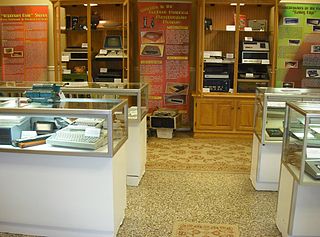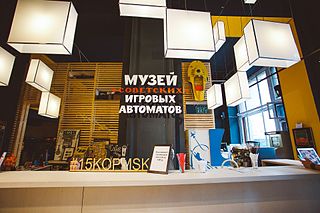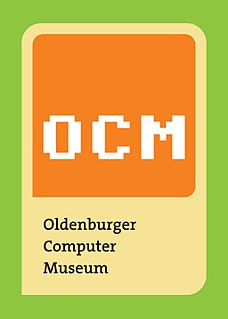 W
WA computer museum is devoted to the study of historic computer hardware and software, where a "museum" is a "permanent institution in the service of society and of its development, open to the public, which acquires, conserves, researches, communicates, and exhibits the tangible and intangible heritage of humanity and its environment, for the purposes of education, study, and enjoyment", as defined by the International Council of Museums.
 W
WThe Bugbook Historical Microcomputer Museum was a small display of several hundred key items from the collection of computer hobbyist David G. Larsen. The Museum was developed and maintained by the LCF Group in Floyd, Virginia from 2008-2016. The name of the museum comes from the Bugbooks and Blacksburg Continuing Education Books a, a series of instructional books created by the "Blacksburg Group" during the late 1970s & 80's. David was a part of the group. The museum closed in May 2016 and Larsen donated the majority of his collection to the Computer Museum of America in Roswell, Georgia.
 W
WThe Computerspielemuseum is a video game museum founded in 1997. From 1997 to 2000, it had a permanent exhibition in Berlin. Afterwards, it became an online only museum. In 2011 the museum reopened its permanent exhibition in Berlin's neighborhood of Friedrichshain, on Karl-Marx-Allee. During the first month of its permanent exhibition, it had 12,000 visitors.
 W
WThe Museum of Computing in Swindon, England is dedicated to preserving and displaying examples of early computers. It was the first United Kingdom museum exclusively dedicated to the history of computing and opened in February 2003.
 W
WEnter is a museum for computer and consumer electronics in the Swiss town of Solothurn. Now a non-profit foundation, it originated as the project of Swiss entrepreneur Felix Kunz. It is the largest private technology collection open to the public in Switzerland. Its current location in Solothurn opened in 2011.
 W
WThe Heinz Nixdorf MuseumsForum (HNF) in Paderborn, Germany, is the largest computer museum in the world. It is named after the Paderborn computer pioneer and entrepreneur Heinz Nixdorf.
 W
WThe HomeComputerMuseum is an interactive museum about the history of the home computer. The museum is located in the city of Helmond in the Netherlands.
 W
WLiving Computers: Museum + Labs (LCM+L) is a computer and technology museum located in the SoDo neighborhood of Seattle, Washington. LCM+L showcases vintage computers which provide interactive sessions, either through time-sharing operating systems or single-user interfaces. This gives users a chance to actually use the computers on-line or in person in the museum. An expansion adds direct touch experiences with contemporary technologies such as self-driving cars, the internet of things, big data, and robotics. This puts today's computer technology in the context of how it's being used to tackle real-world issues. LCM+L also hosts a wide range of educational programs and events in their state-of-the art classroom and lab spaces.
 W
WThe Musée Bolo or Swiss Museum of Computer Science, Digital Culture and Video Games is a private museum dedicated to the digital revolution. Its exhibition space is located on the site of the École Polytechnique Fédérale de Lausanne (EPFL) in Lausanne, Romandy, Switzerland. Its main storage area is located near Lausanne Train Station.
 W
WThe Museum of Soviet Arcade Machines is a private historical interactive museum that keeps a collection of arcade machines that were produced in the USSR from the mid-1970s. April 13, 2007 is considered to be the foundation day of the museum. Visitors of the museum are given 15-kopeck coins at the entrance to get the arcade machines started. The ticket price also includes an excursion.
 W
WThe National Museum of Computing is a museum in the United Kingdom dedicated to collecting and restoring historic computer systems. The museum is based in rented premises at Bletchley Park in Milton Keynes, Buckinghamshire and opened in 2007. The building — Block H — was the first purpose-built computer centre in the world, hosting six Colossus computers by the end of World War II.
 W
WThe Nexon Computer Museum is a museum on Jeju Island, South Korea. It opened on July 27, 2013. It is known as one of the first permanent museum in Korea that is dedicated for the history of computer and video games. In 2017, the museum houses 6,900 items including personal computers, video game consoles, arcades, and software. The museum's supporters include institutions such as Computerspielemuseum Berlin and International Center for the History of Electronic Games, and IT companies such as Nexon, Softmax, Gamevil, Oculus VR, Thalmic Labs, Take-Two Interactive, Sony Computer Entertainment, etc. The principle of Nexon Co. Ltd.'s museum is to interact and communicate with a range of visitors from across boundaries, by collecting, preserving, researching, exhibiting and educating historic digital artifacts.
 W
WThe Oldenburg Computer Museum (OCM) is a museum founded in 2008 in Oldenburg (Oldb), Lower-Saxony, Germany that is dedicated to the preservation and operational presentation of the history of home computing.
 W
WThe Personal Computer Museum was located in Brantford, Ontario, Canada, in a building formerly owned by the municipal government. The building was built with bricks reclaimed from the Brantford Opera House.
 W
WThe Virtual Museum of Computing (VMoC) is an eclectic collection of links and online resources concerning the history of computers and computer science. It includes links to other related museums, both real and virtual, around the world, as well as having its own virtual galleries of information. A particular feature is the early computing pioneer Alan Turing, among others.